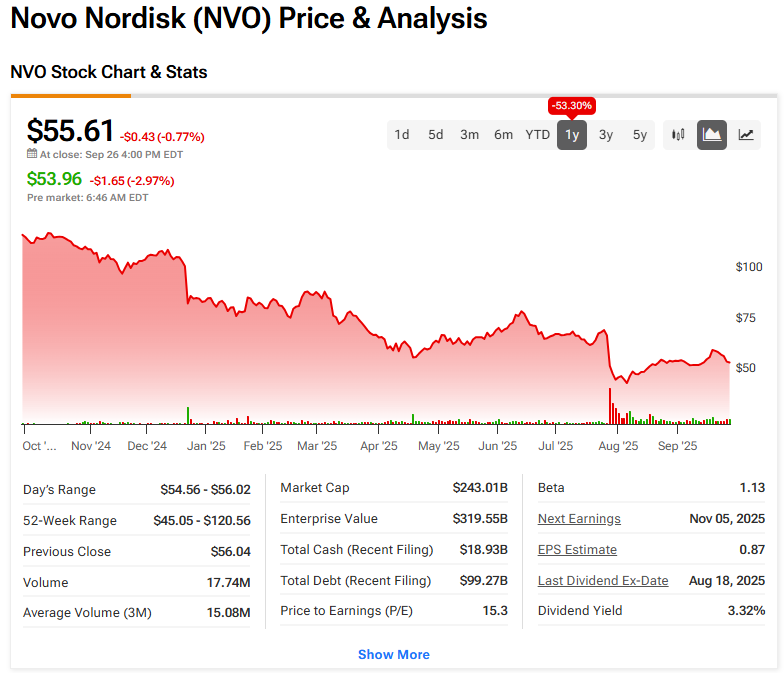Not long ago Novo Nordisk (NYSE:NVO) stock held the title of Europe’s largest company by market cap, but the shares have been under huge pressure over the past year; investors have lost confidence in the maker of weight-loss drugs Ozempic and Wegovy, and the Danish pharma giant’s stock has collapsed to the tune of 53%, weighed down by slower demand for its obesity treatments, sustained sales of alternative products and ongoing competition from Eli Lilly.
Elevate Your Investing Strategy:
- Take advantage of TipRanks Premium at 55% off! Unlock powerful investing tools, advanced data, and expert analyst insights to help you invest with confidence.
But for those thinking now might be a good time to go bottom fishing and pick up shares at a discount, Morgan Stanley analyst Thibault Boutherin has some bad new news. “We expect downward revisions to 2026-27 consensus from slower US GLP-1 prescription growth and competitive pressure, and we see catalysts with downside risk over the next 6 months,” the analyst said. “As the window before semaglutide US/EU LOE narrows, we expect valuation multiples to compress.”
Accordingly, Boutherin has now downgraded his NVO rating from Equal-weight (i.e., Neutral) to Underweight (i.e., Sell) while also lowering his price target from $59 to $47. There’s downside of 15.5% from current levels. (To watch Boutherin’s track record, click here)
Boutherin is calling for 5% sales growth in both 2026 and 2027, below consensus estimates of 8% for each year. In the US, prescriptions for Ozempic and Wegovy have stagnated, and the analyst expects the US GLP-1 diabetes franchise to decline in 2026 given market share losses and pricing pressure. Outside the US, Boutherin sees Ozempic growth constrained by the arrival of generic competition in Canada and certain emerging markets, which Novo has indicated could weigh on growth by a low-single-digit percentage. For Wegovy, Boutherin forecasts only modest gains, as uptake will remain hampered by compounded GLP-1 competitors in the US and by tirzepatide globally. The analyst does see a $1 billion boost in 2026 from the launch of oral Wegovy, though Novo will likely face a strategic tradeoff between defending injectable GLP-1 pricing and positioning the oral version competitively against Eli Lilly’s orforglipron.
Looking ahead, Boutherin counts several “downside risk catalysts” over the next 12 months. First, data from the semaglutide Alzheimer’s program (EVOKE) are expected soon, and Boutherin thinks there’s a 75% probability that the trials will not reach statistical significance, which could create high-single-digit downside pressure on the shares, while the upside NPV in the event of success appears limited. Second, there’s the US Medicare Part D pricing announcement for semaglutide by November 30 (or potentially earlier), with the analyst modeling a 50% net price cut in Medicare Part D – which accounts for over 30% of Ozempic’s US sales, or roughly 7% of Novo’s total group sales – with additional downside risk if US net prices align with European levels. Third, the FY26 guide in February could result in consensus revisions. Finally, the CagriSema versus Zepbound head-to-head study (REDEFINE-4) is a concern, with Boutherin believing a “lack of differentiation is a downside risk.”
So, that’s the Morgan Stanley view, but what does the rest of the Street think lies ahead for NVO? With an additional 4 Buys and 2 Holds, the analyst consensus rates the stock a Moderate Buy. At $59.55, the average target factors in a one-year gain of 7%. (See NVO stock forecast)

To find good ideas for stocks trading at attractive valuations, visit TipRanks’ Best Stocks to Buy, a tool that unites all of TipRanks’ equity insights.
Disclaimer: The opinions expressed in this article are solely those of the featured analyst. The content is intended to be used for informational purposes only. It is very important to do your own analysis before making any investment.
















